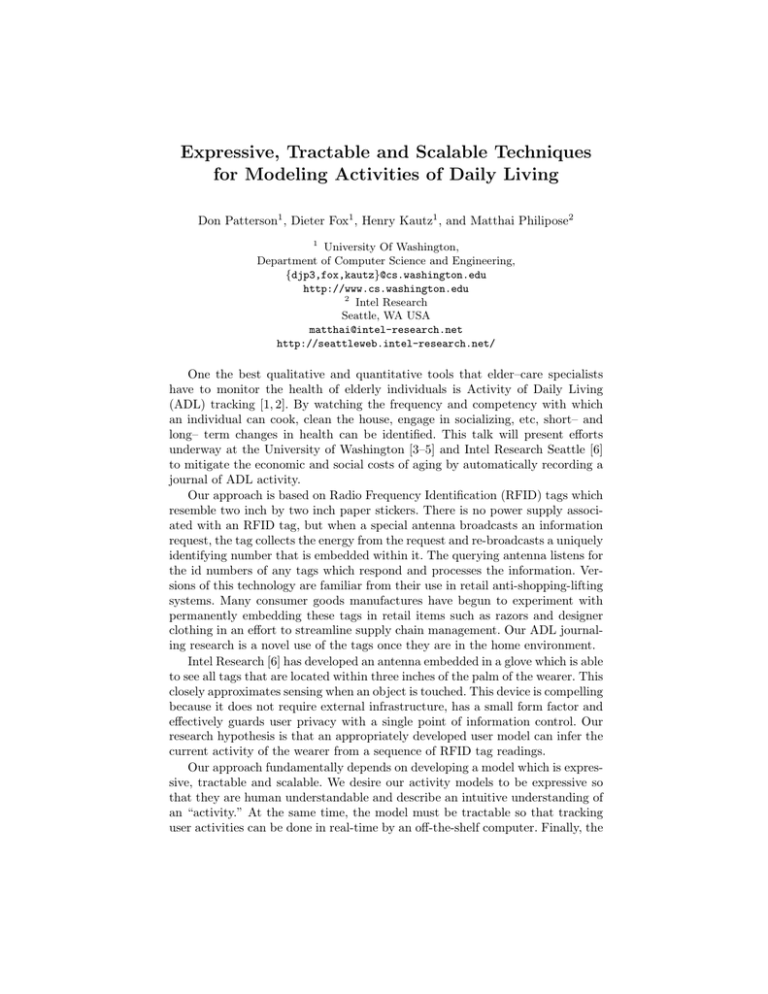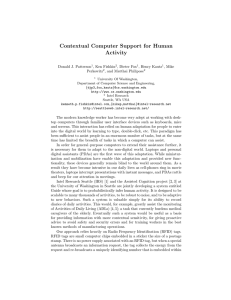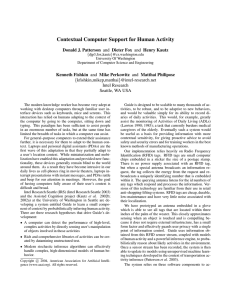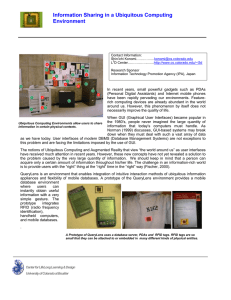Expressive, Tractable and Scalable Techniques for Modeling Activities of Daily Living
advertisement

Expressive, Tractable and Scalable Techniques
for Modeling Activities of Daily Living
Don Patterson1 , Dieter Fox1 , Henry Kautz1 , and Matthai Philipose2
1
University Of Washington,
Department of Computer Science and Engineering,
{djp3,fox,kautz}@cs.washington.edu
http://www.cs.washington.edu
2
Intel Research
Seattle, WA USA
matthai@intel-research.net
http://seattleweb.intel-research.net/
One the best qualitative and quantitative tools that elder–care specialists
have to monitor the health of elderly individuals is Activity of Daily Living
(ADL) tracking [1, 2]. By watching the frequency and competency with which
an individual can cook, clean the house, engage in socializing, etc, short– and
long– term changes in health can be identified. This talk will present efforts
underway at the University of Washington [3–5] and Intel Research Seattle [6]
to mitigate the economic and social costs of aging by automatically recording a
journal of ADL activity.
Our approach is based on Radio Frequency Identification (RFID) tags which
resemble two inch by two inch paper stickers. There is no power supply associated with an RFID tag, but when a special antenna broadcasts an information
request, the tag collects the energy from the request and re-broadcasts a uniquely
identifying number that is embedded within it. The querying antenna listens for
the id numbers of any tags which respond and processes the information. Versions of this technology are familiar from their use in retail anti-shopping-lifting
systems. Many consumer goods manufactures have begun to experiment with
permanently embedding these tags in retail items such as razors and designer
clothing in an effort to streamline supply chain management. Our ADL journaling research is a novel use of the tags once they are in the home environment.
Intel Research [6] has developed an antenna embedded in a glove which is able
to see all tags that are located within three inches of the palm of the wearer. This
closely approximates sensing when an object is touched. This device is compelling
because it does not require external infrastructure, has a small form factor and
effectively guards user privacy with a single point of information control. Our
research hypothesis is that an appropriately developed user model can infer the
current activity of the wearer from a sequence of RFID tag readings.
Our approach fundamentally depends on developing a model which is expressive, tractable and scalable. We desire our activity models to be expressive so
that they are human understandable and describe an intuitive understanding of
an “activity.” At the same time, the model must be tractable so that tracking
user activities can be done in real-time by an off-the-shelf computer. Finally, the
Make Tea
(Activity)
(Activity Node)
(Activity Node)
(Activity Node)
Boil Water
µ=10 minutes
Steep Tea
µ=3 minutes
Prepare Tea
µ=3 minutes
}
}
}
Teapot
Teapot
Faucet
Stove
(Object Touches)
Tea
Bag
Spoon
Cup
Tea
Bag
Cup
(Object Touches)
Sugar
Milk
(Object Touches)
Fig. 1. Visualization of an Activity Model
scope of our vision (which extends to tracking more activities than just ADLs)
requires that the models be scalable. They must be able to accommodate a full
range of consumer goods and hundreds or thousands of activities, and as such
we require that the models can be computer generated.
To meet these constraints, we have developed an activity model which describes an activity as a sequence of “bags of touched objects” (see Fig. 1). More
formally we describe the model as follows: Let Ri indicate that object i has been
touched. Let D(µ, σ) be a Gaussian distribution over a time duration which describes the expected amount of time over which all the objects will be touched.
An activity node, a (e.g. boil water), is an unordered set of object touches (e.g.
teapot, faucet, stove) paired with an expected duration: a = [{Ra1 . . . Ran }, Da ].
A full activity, A (e.g. make tea), is an ordered sequence of activity nodes:
A =< a1 , . . . , ak >.
A full activity’s expected time distribution
Pkis the sum of the distributions of
the activity nodes which it contains: DA = i=1 Dai .
Our activity model closely mirrors the structure of a recipe with several ordered steps each of which is individually loosely structured. As such, we generate
our models by mining activity and recipe web sites [7].
Once our models are built we translate them into a Dynamic Bayesian Network. We have custom built an inference engine which uses the models and the
data stream from the RFID glove to track user activities. The inference engine
uses a particle filter based method to approximate finding the solution to the
maximally likely sequence of states given the observations. A user’s ADL journal
can then be generated from this sequence of states.
We have promising preliminary results based on simulated data, as well as
results from real data taken from 10 people performing ADLs in a tagged home.
Using extensions to work on Voronoi graph tracking [8] that we developed
in the context of transportation tracking [9], we anticipate being able to learn
better activity models as well as idiosyncratic patterns of particular activities
that a user exhibits.
1
Author’s Biographies
– Donald J. Patterson is a Ph.D. candidate in the Computer Science Department at the University of Washington. He graduated from Cornell University
with a B.S. in Computer Science and an M.Eng. in Electrical Engineering.
After spending a few years in the military, he returned to academia as an
NDSEG fellow and is currently researching artificial intelligence and its application to health care through the Assisted Cognition Project. He is spending
the summer working on ubiquitous computing applications at Intel Research
Seattle.
– Dieter Fox is an Assistant Professor in the Department of Computer Science
and Engineering at the University of Washington. He joined the faculty in
the fall of 2000. He grew up in Bonn, Germany, and received a B.Sc. in
1990, an M.Sc. in 1993, and a Ph.D. in 1998, all from the computer science
department at the University of Bonn. Before going to UW, he spent two
years as a Postdoc in CMU’s robot learning lab. Dieter Fox heads the AIbased mobile robotics lab which he established in January 2000.
His research interests lie in artificial intelligence and its application to mobile
robotics. More recently, he and colleagues introduced particle filters as a
powerful tool for state estimation in mobile robotics.
– Henry Kautz is an Associate Professor in the Department of Computer Science and Engineering at the University of Washington. He joined the faculty
in the summer of the year 2000 after a career at Bell Labs and AT&T Laboratories, where he was Head of the AI Principles Research Department. His
academic degrees include an A.B. in mathematics from Cornell University,
an M.A. in Creative Writing from the Johns Hopkins University, an M.Sc. in
Computer Science from the University of Toronto, and a Ph.D. in computer
science from the University of Rochester. He is a recipient of the Computers
and Thought Award from the International Joint Conference on Artificial
Intelligence and a Fellow of the American Association for Artificial Intelligence . In 1998 he was elected to the Executive Council of AAAI, and in
2000 was Program Chair for the AAAI National Conference.
– Matthai Philipose is a researcher at Intel Research Seattle. His chief interest is
in making ubiquitous computing systems useful and practical. Currently, he
co-leads the Guide project (which is devoted to acquiring and understanding
RFID data), and leads the River project (which is devoted to understanding
how to make ubiquitous computing systems easier to manage). He did his
graduate work at the University of Washington, and his undergraduate work
at Cornell University.
References
1. Lawton, M.P.: Aging and Performance of Home Tasks. Human Factors 32 (1990)
527–536 NLM:0374660;PMID:2074107.
2. Lawton, M.P.: Environment and Other Determinants of Well-Being in Older People.
The Gerontologist 23 (1983) 349–357 NLM:0375327;PMID:6352420.
3. Patterson, D., Etzioni, O., Fox, D., Kautz, H.: The Activity Compass. In: Proceedings of UbiCog ’02: First International Workshop on Ubiquitous Computing for
Cognitive Aids, Gothenberg, Sweden (2002)
4. Kautz, H., Arnstein, L., Borriello, G., Etzioni, O., Fox, D.: The Assisted Cognition
Project. In: Proceedings of UbiCog ’02: First International Workshop on Ubiquitous
Computing for Cognitive Aids, Gothenberg, Sweden (2002)
5. Kautz,
H.,
Fox,
D.,
Etzioni,
O.,
Borriello,
G.,
Arnstein,
L.:
An Overview of the Assisted Cognition Project (2002)
http://www.cs.washington.edu/homes/kautz/ac/acaaai02.pdf.
6. Intel Research Seattle: Intel Research Seattle Guide Project Website (2003)
http://seattleweb.intel-research.net/projects/guide/.
7. Philipose, M., Fishkin, K., Fox, D., Kautz, H., Patterson, D.J., Perkowitz, M.:
Guide: Towards Undestanding Daily Life via Auto-Identification and Statistical
Analysis. In: Proceedings of UbiHealth 2003: The 2nd International Workshop on
Ubiquitous Computing for Pervasive Healthcare Applications, Seattle, Washington,
USA (2003)
8. Liao, L., Fox, D., Hightower, J., Kautz, H., Schulz, D.: Voronoi tracking: Location
estimation using sparse and noisy sensor data. In: Proceedings of the International
Conference on Intelligent Robots and Systems (IROS), IEEE/RSJ (2003) To appear.
9. Patterson, D.J., Liao, L., Fox, D., Kautz, H.: Inferring High-Level Behavior from
Low-Level Sensors. In: Proceedings of UBICOMP 2003: The Fifth International
Conference on Ubiquitous Computing. (2003)





